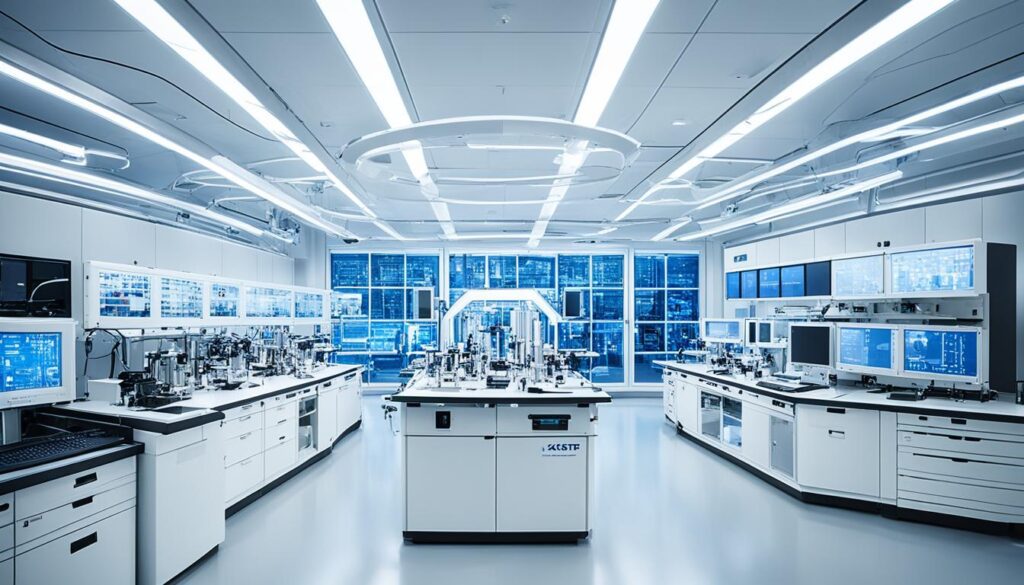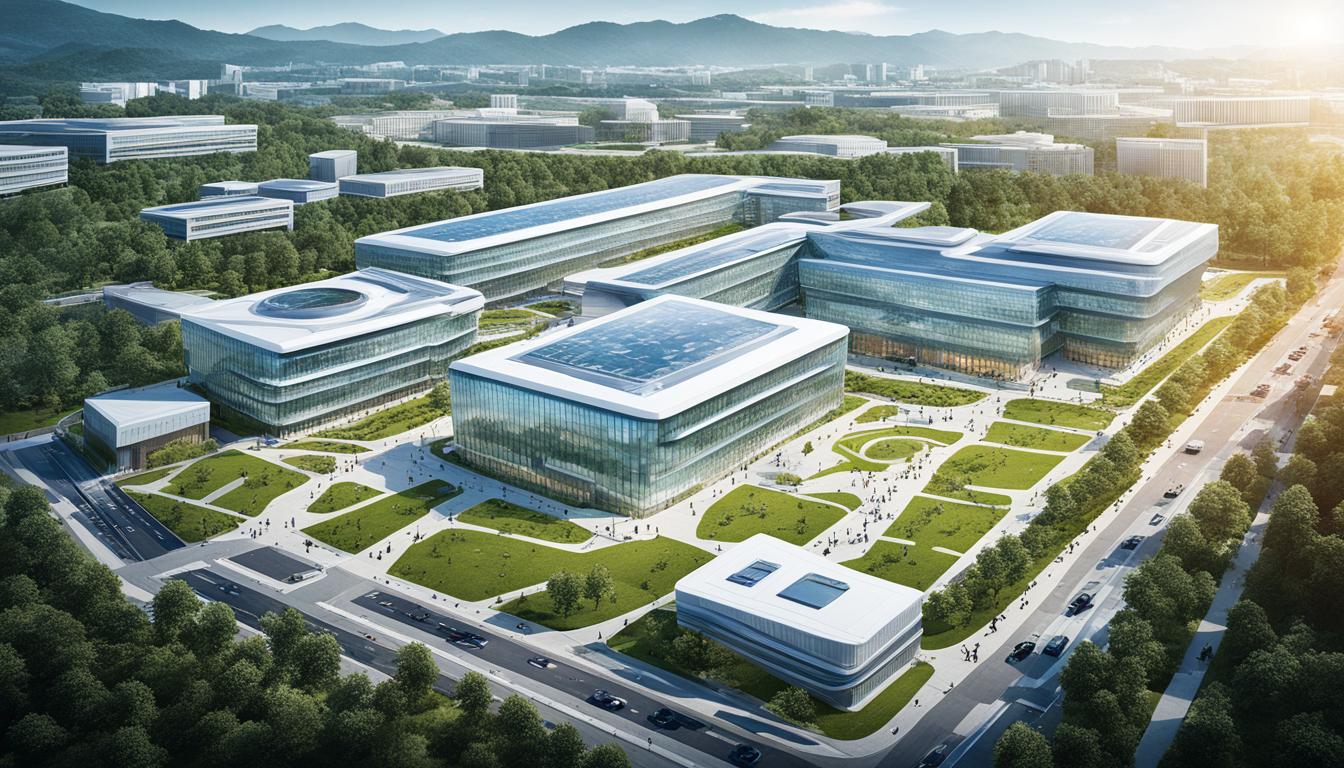The Korea Advanced Institute of Science & Technology (KAIST) stands as a leading light of innovation in East Asia. It’s South Korea’s symbol of excellence in educating future leaders in science and technology. From its beginning, KAIST has shaped South Korea into a hub for new scientific and tech discoveries.
It has raised a group of outstanding individuals. These people have placed KAIST at the top in Korea and highlighted its role globally in science and tech fields.
KAIST has played a big part in driving South Korea’s economic growth by fostering entrepreneurs and innovators. It dedicates itself to lifting science and technology to new heights. Its goal is to bring prosperity worldwide, starting from the Korean peninsula.
The accomplishments of KAIST show it’s not just a leader in East Asia. It’s an influential institution in the global academic community, especially in technology.
Key Takeaways
- KAIST is South Korea’s first science and tech-focused institution.
- It is acknowledged globally as a top university in Korea and East Asia.
- Contribution to innovation, entrepreneurship, and economic growth is central to KAIST’s mission.
- The institution has a significant role in advancing global science and technological progress.
- KAIST’s commitment to education and research underpins its stature as a global leader.
- Efforts at KAIST aim to create impactful advancements with widespread benefits.
The Founding Story and Vision of KAIST
The start of KAIST, the Korea Advanced Institute of Science & Technology, was a key moment for education in Asia. It quickly became a center for new ideas and top-notch research. As a leading research institute, KAIST aimed to excel globally and create new knowledge.
Birth of a Pioneer: The Establishment of KAIST
KAIST was created to make South Korea a leader in science and tech. The government supported this vision. They wanted the country to be a global competitor through research and innovation.
Guiding Progress: Mission and Vision Statements
KAIST aims to help society by training leaders in science and tech. It focuses on being a global leader and inspires students to take charge of worldwide projects. Its goal is to improve the world through ethical research and knowledge.
Mapping the Future: Vision 2031 & Global Impact
Looking towards Vision 2031, KAIST is dedicated to being a globally impactful university. It wants to be a leader in new tech and ideas that help the world. Vision 2031 is about shaping a future where innovation and sustainability thrive together.
KAIST – Korea Advanced Institute of Science & Technology in South Korea
In the lively city of Daejeon, KAIST stands as a key advanced research institution. It enriches South Korea’s innovative scene. Being a top university in Korea and a leading technology university in East Asia, KAIST’s campus is widespread. It houses a mix of colleges, schools, and grad programs.
KAIST is home to over 15,000 students and 1,574 faculty. They are spread over five colleges, seven schools, and 27 departments. Located 160 km south of Seoul, Daejeon is not just KAIST’s home. It’s also a center for many research institutes. This creates a strong culture of science and tech innovation.
| College/School | Number of Students | Faculty Members |
|---|---|---|
| College of Natural Sciences | 3,000 | 300 |
| School of Computing | 2,500 | 250 |
| Graduate School of AI | 1,200 | 120 |
| School of Engineering | 4,000 | 400 |
| College of Business | 2,000 | 200 |
| Graduate School of Medical Science & Engineering | 800 | 80 |
| Department of Bio & Brain Engineering | 1,500 | 150 |
Daejeon is a hub for South Korea’s advanced scientific and technological breakthroughs. With KAIST at its heart, the city leads these advancements. This partnership promotes academic excellence and applies research in the real world. It keeps KAIST’s name high as a technology university in East Asia with a global impact.
KAIST’s Innovative Education Model & Academic Excellence
KAIST stands at the forefront of South Korea’s tech progress. It’s not just a top research hub. It also works hard to ensure its graduates succeed. The university creates educational plans to boost students’ intellect and creativity.
Comprehensive Academic Structure: Colleges, Schools, and Departments
KAIST offers a wide range of subjects within its organized educational system. It includes colleges, schools, and departments. This setup supports a variety of academic interests. Areas like engineering, sciences, business, and liberal arts are covered, all promoting a multidisciplinary way of learning crucial for future leaders.
Cultivating Minds: A Focus on Graduate Success
KAIST sets a high bar for its graduates, offering challenging academic programs. These programs meet the needs of global advancement and sustainability. The school is dedicated to blending theory with real-world skills, readying students to thrive globally.
Learning with the Masters: Distinguished Faculty and Staff
KAIST boasts a team of skilled and passionate faculty members. They are more than teachers; they are leading researchers. Their deep knowledge and love for research and innovation greatly enhance students’ learning and achievements.

A Closer Look at KAIST’s Research and Technological Advances
In South Korea, KAIST – Korea Advanced Institute of Science & Technology is a key player in science. As a premier technology university in East Asia, it leads in innovations that affect us locally and worldwide. Its research spans many areas, making it a top advanced research institution.
KAIST has made big strides in academia and real-world tech over the years. It brought us Korea’s first portable calculators and was a pioneer in digital color TV. Their latest work in AI and robotics shows they’re always pushing forward. The creation of humanoid robots is a perfect example of their dedication to making science practical.
The upgrade of engineering and tech sectors is vital for South Korea’s economic plans. By focusing on these areas, KAIST helps ensure research turns into real economic gains. It’s at the heart of innovation, setting new industrial standards.
KAIST focuses on several important research areas like nanotechnology, wireless communications, and making energy use better. These areas are vital for creating innovations that benefit society. They show KAIST’s significant role in science around the world.
- Nanotechnology: Pushing the limits of material sciences to develop smaller, more efficient technology.
- Wireless Communications: Enhancing connectivity to advance communication technologies further.
- Energy Sustainability: Finding new ways to reduce our carbon footprint and promote renewable energy sources.
KAIST goes beyond just research. It’s a leader in global tech and innovation. Through key partnerships, KAIST creates a space where research and industry grow together. This approach is essential for progress in science and tech, showing KAIST’s aim to make a real difference.
Life in Daejeon: The City of Science and KAIST’s Main Campus
Daejeon stands as a beacon of innovation, linking closely with the Korea Advanced Institute of Science & Technology (KAIST). It’s more than just a city. It nurtures and stimulates those who will shape our future. With KAIST at its heart, Daejeon blends research and technology seamlessly. This synergy creates a vibrant atmosphere of discovery throughout the city.
City of Innovation: Daejeon’s Contribution to Science and Technology
In Daejeon, progress and research go hand in hand, thanks to institutions like KAIST. The city is a key player in science and technology, leading with around 200 R&D centers. It’s a thriving ecosystem for innovation, making Daejeon a core hub in East Asia’s tech landscape.
KAIST and Daedeok Innopolis: A Synergetic Relationship
Daedeok Innopolis and KAIST share a strong bond that drives both to new heights. This partnership creates a fertile ground for innovation. It mixes academia with industry, setting the stage for breakthroughs. Together, they push the limits, placing KAIST on the global map of research excellence.
Everyday Life on Campus: Culture and Facilities at KAIST
KAIST’s campus life is rich with academic and cultural activities. It’s renowned not just for education but for the experience it offers. The campus boasts diverse facilities, from the Mazinger Tower to Newton’s Apple Tree. These spaces inspire creativity. The community at KAIST fosters a supportive atmosphere, vital for grooming tomorrow’s leaders in Daejeon’s vibrant setting.

